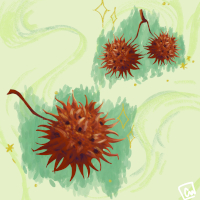Critical study of the pageant system by local scholar yields controversial results
Monday, April 4th
By Phil Ungland
BIRD-IN-HAND - Dr. Sally Duckworth not only believes that the Bird-in-Hand County Little Miss Pageant and Scholarship Competition is harmful to its participants, she has proof. For the last decade, Dr. Duckworth, a sociologist at the nearby state research university, has been conducting a study, gathering data from pageant participants around the country. Three hundred former pageant winners were interviewed, as well as three hundred females who had never participated in a beauty pageant competition. They were evaluated and compared in categories such as body mass index, self-esteem, maternal relationships, hygienic routines, and overall bodily perception and satisfaction.
In general, Dr. Duckworth’s study (conducted with the help of graduate students at the nearby state research university) found that those females who competed in beauty pageants had stunted corporal perception and satisfaction, greater impulse dysregulation, and higher incidences of trust issues with both humans and animals.
But not everyone is so sure Dr. Duckworth’s study reveals the truth.
“I participated in eleven pageants before I was 18 and I won four of them,” says Eureka Shepherd-St. Regis of Lionsrigdge. “I have an incredible life, incredible kids, an incredible husband. Even my nanny is incredible. Everything about Eureka Shepherd-St. Regis is incredible.” You can find out more about this incredible life at Ms. Shepherd-St. Regis’s blog, Incredible Eureka!
However, Dr. Duckworth is not so easily shaken. She insists that though the results to any study will have its outliers, the outlook for pageant girls is nearly always grim.
“It’s a real jungle out there,” says Duckworth, “These pageants show just how far we haven’t come as a society. Something needs to be done.”
When asked why she’ll allow her daughter, Katie, 13, to participate in the upcoming Little Miss Pageant, Dr. Duckworth responded before promptly ending the interview, “My daughter made a choice that we’ll both have to live with, but I love her. What can you do?”
Mr. and Mrs. Lightly build a family
When Gray Lightly took the stage to show the pageant audience her talents, her parents, Stan and Mabel Lightly, couldn’t help but think about how far their daughter had come. The pale girl on stage getting ready to reveal a science project she’d been working on was the product of years of tireless labor and research.
Mabel Lightly née Lipsheim was diagnosed with ovarian cancer when she was thirty, two years before she met and married Stan Lightly, a fellow graduate student of bioengineering at the state research university. Her appetite had disappeared and her pelvis began to feel tender and stone heavy. The doctor told her they had to move quickly. Like all things in her life, Mabel Lipsheim approached her diagnosis pragmatically. She looked at the statistics. She weighed her options. She had her reproductive organs removed. Her body was pumped with chemicals until she was well again.
Then she met Stan.
For years the subject of children simply did not come up. Stan and Mabel were deep into their research. Early in their marriage they designed robotic arms for factories around the country and had patents on several different arm models. One robo-arm was specifically designed for writing inscriptions on candy conversation hearts. Another was created for the flicking lint off newly sewn cardigans. After six years designing these robotic arms, they decided to move onto legs. The Lightly Robotic Leg came together within three years. It was a resounding success among amputees. War veterans, car crash victims, thousands of amputees around the world found their footing again with Lightly Legs.
But the Lightlys soon grew bored of tinkering with mechanical appendages. Arms and legs could only carry out so many functions. That’s when Mabel had an idea. She and her husband could build themselves a child. She was not a particularly motherly woman. She had never really entertained the idea of having a child, but if it meant precipitating her scientific inclinations, building a child might just be the kind of nurturing impulse she could endorse.
And so for nearly a decade, Stan and Mabel puzzled through the construction of a daughter.
Gray came about slowly. In her early stages, she was nothing more than a tangle of wire and cable, a simple wind-up automaton, but even then, Little Gray was a curious and affectionate child. She would follow her parents around their farmstead observing the chickens’ feeding patterns, measuring the frequency of the old lowing heifer, studying the barn cats skittering in the loft. She was always close behind Stan and Mabel, always cranking her little gears into a wide metal grin as she took in her world.
Over the years, a humanoid girl took shape. Brunette strands of synthetic fiber haloed a plasticine-swathed cranioshell. Scores of lint-free cardigans draped alumino- plasticine shoulders as she studied the musculoskeletal composition of the barn cats. The metal grin was replaced by a smiling mouthful of a porcelain veneers. Eventually she even began accompanying her parents on trips off the farmstead.
Of course, Gray was aware of what the world outside the farm would be like. Wireless Internet had afforded her countless glimpses into what lay beyond the Lightly Farm. But the opportunity to be among other humans was exhilarating. She took any chance to go along with her parents. Even the most mundane errand was a gift. The supermarket was a multicolored labyrinth of persons and products, a crowded maze of permutational possibility. Bird-in-Hand Square was a similarly vibrant jostle. Here humans could seek community and companionship. They could mail letters, buy cones of frozen custard, sip cappuccinos, walk with dogs, throw Frisbee discs, get in arguments, parallel park cars, read newspapers, or throw trash into properly labeled receptacles. They could laugh and gossip. They could hug.
Gray’s titanium bone replicants ached with longing to be among them. She loved her parents, the cats and the cows, but she grew lonely for the world at times. She grew lonely for the companionship of her peers.
That was how she found the Little Miss Pageant. An Internet search led her to a scholarly article by a local professor of sociology named Sally Duckworth. A pageant. The opportunity to be among other girls her age. The opportunity for companionship. She begged her parents to sign her up. There was no rule that stated a participant couldn’t be made of metal alloys. Stan and Mabel consented through a loosely coiled knot of befuddlement. It was just one day, after all.
A dress was designed and sewn. A bathing suit was purchased. A talent act was planned. Soon, the day of the pageant arrived.
That morning, Gray had whirred with excitement, a low purring drone.
“Now remember, Gray,” Mabel had said outside the doors of the Munificent Order of the Sons of the Frontier Lodge, “Other girls in the pageant may have done this before. It’s okay if you lose. And don’t be upset if the other girls aren’t quick to companionship.” Gray had nodded impatiently.
“Just being around them is a start, Mother. I can study them. I can find a point of entry.”
Now in the back row of the lodge auditorium, Mabel and her husband watched with pride as their mechanical daughter, the last contestant to perform, unveiled the first ingredient of her Talent act to the audience: A large black leather bag heavy with clanking metal.
A Brief History of the Curling Iron
The earliest patent for a curling iron design dates back to 1866 and belongs to Hiram Maxim, an inventor most known for having patented the Maxim Gun, the world’s first machine gun.
Maxim’s original design led to countless iterations of the curling iron from the Depose 11 ½ in. stove-heated hair iron all the way to the TotalBrat Heat Wave 2 in. barrel curling iron, a model most favored by teen girls like Junie-Rae Wright, whose own hair was at this moment in the curling iron’s reputable history beginning to catch fire in the dressing room of the Munificent Order of the Sons of the Frontier Lodge from the heat of prolonged exposure.
Billy Glin’s first lesson in feline biomechanics
“Dude, it was bizarre. My mom made me go to my sister’s pageant, and it turned into like this science fair shit. So the last girl gets up on the stage with this big black bag, and I think for sure she’s just going to pull out a dead body or something. The bag was huge, man, a serial killer bag for sure. So she lugs this bag out and starts talking to the crowd. She’s like, “According to Scientific American blah blah blah bull shit,” and she’s seriously like lecturing the crowd, saying all this crap I don’t understand. And this whole time, I’m like, what’s in the bag? What’s in this goddamn bag? And she’s just walking around the stage talking about these cats she’s studied. I guess they live in her barn out in the boonies? I don’t know. Anyway, she’s talking about these cats and their bones or something. And then she’s all like, “I built a cat robot,” and I was like shit, I want to see this cat robot. But she just keeps on freaking talking. She won’t stop talking, and I’m like, why would you mention a cat robot and not show us a cat robot? I have to watch freaking twelve-year-olds prance around in their little dresses and feel like a total perv, and you mention this cat robot, and then you don’t show it to me?! What the hell, dude, right? Anyway, so finally, she walks over to this bag, and it’s like, yes. This is it. This is the cat robot. Boo-yah. Right? Wrong. The bag is full of like scraps of the metal. I know, man. It was messed up. But just wait. So she dumps all this metal onto the stage, and it sounds like a freaking garbage truck unloading a dumpster. All this shit is all over the stage. Then she walks to the front of the stage and says, “According to veterinary legend, it has been said that cats are able to reassemble their bones when placed in the same room with all their parts.” No, seriously. That’s what she said. I remember that part because I was like: shit, bro. So, then she reaches into this pocket in her dress and pulls out a little gear or something and tells the crowd the metal is a disassembled cat. She drops the little gear on the floor and then it’s just like total insanity. All the little pieces and parts start shaking, and at this point, I’m kinda scared. Like I might piss myself—dude, I’m serious. You would have been freaked out, too. The pieces all start moving around and pushing across the stage. And this girl is just standing there like this is totally normal. They start coming together and finding each other and, dude, it was like some wizard shit. Bro, I’m serious. The thing just rebuilt itself. After like three minutes, there was a robot cat on the stage just like walking around and cleaning itself. It was so epic.
Yeah, then I left because I got a text from Steve saying he’d scored some choice bud from Dave because Kelsey dumped his ass again. Naw, man. It wasn’t that good.”



